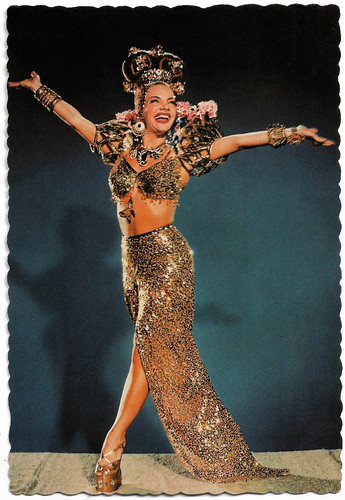
Canadian postcard by the American Postcard Co., no. 1123. Photo: The Gerald Mastroli Collection. Carmen Miranda in Copacabana (Alfred E. Green, 1947).

Italian postcard by Rotalfoto, Milano / Ediz. Garami, no. 129. Photo: Bruno of Hollywood. Carmen Miranda in Down Argentine Way (Irving Cummings, 1940).

Dutch card. Photo: 20th Century Fox. Carmen Miranda and Bando da Lua in Doll Face (Lewis Seiler, 1945).
A fruit-filled turban
Carmen Miranda was born Maria do Carmo Miranda da Cunha in Várzea da Ovelha e Aliviada, a village in the northern Portuguese municipality of Marco de Canaveses in 1909. One of six children, Miranda was named after Georges Bizet's opera 'Carmen', reflecting her father's love of the art.
She moved to Brazil when she was less than two years old to join her father who had set up a barber's shop. Her early artistic roots set her on a path to being a world-renowned musician and dancer. She began performing at an early age and at 20 years old she released her first album.
Miranda's early work was inspired by 'baianas', the Afro-Brazilian fruit vendors she regularly saw during her childhood in Rio de Janeiro. It was working at a hat store that she first discovered her musical talent, which was strongly influenced by the samba music that played throughout the city's favelas. Channelling these influences, Miranda one day decided to don a headdress in the form of a fruit-filled turban inspired by the traditional headdress seen on black women fruit sellers.
Miranda’s big break happened following her performance at the National Institute of Music. She landed an audition at a recording studio where she was immediately signed to put out a single. Miranda’s first album was released in 1929 and was immensely popular among Brazilians. Her performing style helped samba gain respect and a place in the Brazilian (and later, the world) spotlight.
Carmen Miranda made her film debut in the Brazilian documentary A Voz do Carnaval/The Voice of Carnival (Adhemar Gonzaga, Humberto Mauro, 1933). The film includes comic sketches and musical numbers with some of the most popular Brazilian stars and Carmen sang 'Good-bye' and 'Moleque Indigesto' at the studio of Rádio Mayrink Veiga. Two years later she appeared in her first feature film, Alô, Alô, Brasil/Hello, Hello Brazil (João de Barro, Wallace Downey, Alberto Ribeiro, 1935).
However, it was Estudantes/Students (Wallace Downey, 1935) that seemed to solidify Carmen in the minds of the Brazilian film audiences. Now they realised she could act as well as sing. Although there were three years between Alô Alô Carnaval (Adhemar Gonzaga, 1936) and Banana-da-Terra/Banana (Ruy Costa, 1939), Carmen continued to churn out musical hits in Brazil. The latter film would be the last in her home country.
By the time Carmen Miranda moved to the United States in 1939, she was a national star in Brazil. American producer Lee Shubert saw her act in Brazil and offered her a spot on his new Broadway revue 'The Streets of Paris' (1939). Knowing the need for a real Brazilian band to keep the appropriate music true, she insisted that her backup band be included in the deal. With the help of the Brazilian government which saw a good national image opportunity in Carmen, her demand was met.

American postcard by Classico, San Francisco, no. 136-109. Photo: 20th Century Fox / The Ludlow Collection. Carmen Miranda in The Gang's All Here (Busby Berkeley, 1943).

Dutch card by Takken 't Sticht, no. 3534. Photo: 20th Century Fox. Sent by mail in 1950. Carmen Miranda in If I'm Lucky (Lewis Seiler, 1946).
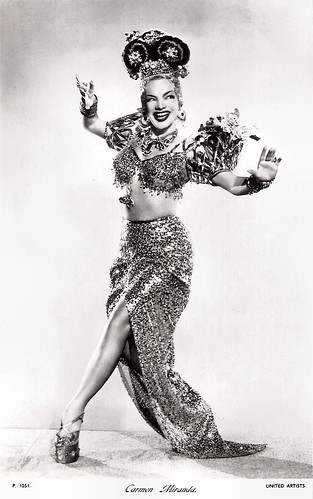
British postcard in 'The People' series by Show Parade Picture Service, London, no. P. 1051. Photo: Virgil Apger / United Artists. Carmen Miranda in Copacabana (Alfred E. Green, 1947).
A visual candy box of Technicolor treats
In late 1939 Carmen Miranda arrived, with much fanfare in the press, in New York City. She was now ready to capture Americans' hearts with her talent. She appeared in some musical revues on Broadway and, just as everyone thought, was a huge hit.
In 1940 Carmen was signed to appear in the Twentieth Century-Fox production Down Argentine Way (Irving Cummings, 1940), with Betty Grable and Don Ameche. The only complaint that critics had was the fact that Carmen was not on the screen enough. Hal Erickson at AllMovie: "She was signed to a long-term 20th Century-Fox contract in 1940, which proved a wise move when World War II dried up the European movie market, leaving South America as practically the only foreign outlet for Hollywood films."
In 1941 she was, again, teamed with Ameche in addition to Alice Faye in A Night in Rio (Irving Cummings, 1941). The film was extremely popular with the theatre patrons. Her unique songs went a long way in making her popular. Hollywood's famous Grauman's Chinese Theatre invited her to leave her hand prints in the cement in 1941, the first Latin American to do so. It was after Week-End in Havana (Walter Lang, 1941) that American cartoon artists began to cash in on Carmen's ever-growing popularity.
In the 1930s and 1940s cartoons were sometimes shown as a prelude to whatever feature film was showing. Sure enough, the cartoon version of Carmen came wriggling across the screen, complete with her trademark fruit hat and wide, toothy grin. In 1942 Carmen starred in Springtime in the Rockies (Irving Cummings, 1942) with Betty Grable and Cesar Romero, both of whom she had worked with before.
It was shortly after this that America began adopting her style of dress as the latest fad. The most outrageous of her musicals was The Gang's All Here (Busby Berkeley, 1943), which Catherine A. Surowiec in the catalogue of Il Cinema Ritrovato 2006 describes as "a visual candy box of Technicolor treats": "Camera-boom-riding choreographic genius Busby Berkeley was given full rein to weave his magic in full 3-strip technicolor for the first time and he pulled out all the stops. The film contains two of his most spectacular, surreal production numbers: the fabulous camp-classic 'The Lady in the Tutti Frutti Hat' (Carmen Miranda and chorus girls literally go bananas!) which for obvious reasons set censors in a spin, and the film's epic kaleidoscopic finale, a triumph of special photographic effects".
Bruce Eder adds at All Movie: "the film keeps us moving, laughing, and humming, and also tapping our feet to the beat of Benny Goodman's orchestra. Berkeley's use of special effects in the service of dance is extraordinary -- gravity seems to disappear at various points, strange, unearthly rings surround performers in mid-air, and nightclubs interiors suddenly lose their walls and ceilings and even their stages, which suddenly become bigger than any building that they could seemingly ever contain them."
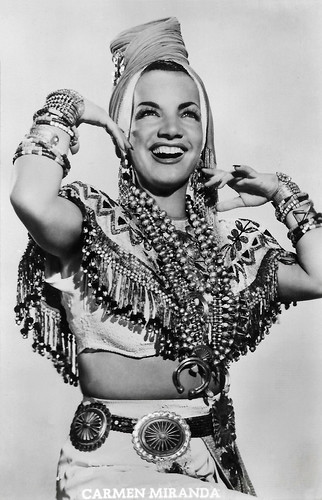
Dutch postcard by Van Leer's Fotodrukindustrie N.V., Amsterdam, no. 1250. Photo: R.K.O.. Carmen Miranda in Springtime in the Rockies (Irving Cummings, 1942).
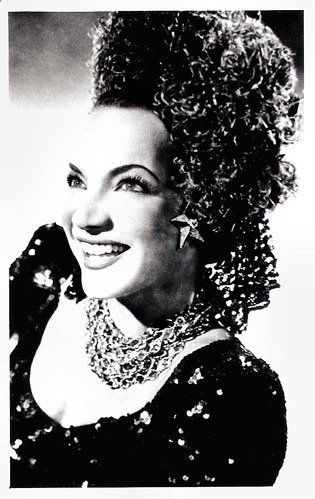
Vintage card. Carmen Miranda in Doll Face (Lewis Seiler, 1945).
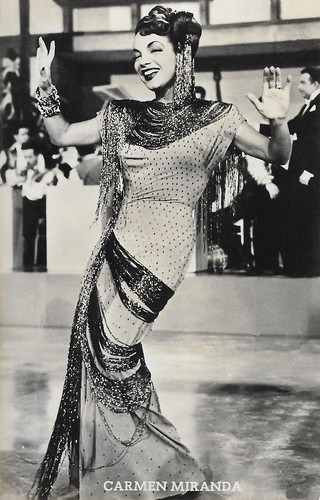
Dutch postcard. Photo: 20th Century Fox. Carmen Miranda in A Date with Judy (Richard Thorpe, 1948).
An abusive and opportunistic brute who made Carmen's life hell
1944 saw Carmen Miranda in three films: Something for the Boys (Lewis Seiler, 1944), Four Jills in a Jeep (William A. Seiter, 1944) and Greenwich Village (Walter Lang, 1944). Denny Jackson at IMDb: "The first two did well at the box office, but the last one left a lot to be desired. It was her last busy year in film.
Carmen made one film each in 1945, '46, '47 and '48. After that, she didn't make a film for two years, until Nancy Goes to Rio (Robert Z. Leonard, 1950), a production for MGM. Once again she didn't make a film for several years, returning with Scared Stiff (George Marshall, 1953)." The studios labelled her the "Brazilian Bombshell", but the films tended to blur her Brazilian identity in favour of a generalised Latin American image.
She did stay busy, singing on the nightclub circuit and appearing on the relatively new medium of television. In 1947, Carmen married film producer David Sebastian. Kenneth Chisholm at IMDb: "He proved to be an abusive and opportunistic brute who made Carmen's life hell. Yet Carmen was a good Catholic and never considered divorce. Instead, she kept up a gruelling schedule of shows, taking uppers and downers to remain functional, even when they began to damage her health. Eventually, she collapsed and her doctor ordered her to go back to Brazil. She recovered and returned to America to resume the grind."
Off-screen, Miranda was a talented sketch artist and costume designer; she was also very active in charitable work, seeing to it that a generous percentage of her earnings were sent to the destitute in South America.
On 4 August 1955, Carmen Miranda suffered a heart attack, although she didn't realize it at the time, during an episode of The Jimmy Durante Show (1954-1956). She went home after attending a party. Early the next morning, on 5 August 1955, Carmen suffered a fatal heart attack. She was just 46 years old. Her body was flown to her adopted country of Brazil, where her death was declared a period of national mourning. The actress' memory is kept alive by the Carmen Miranda Museum in Rio De Janeiro.
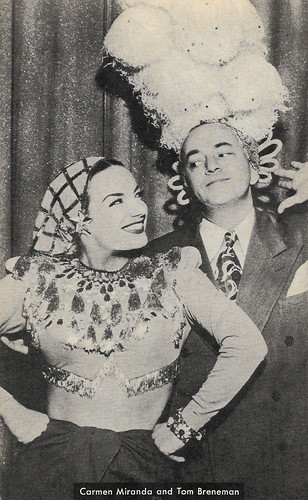
American postcard. Carmen Miranda at the morning radio show 'Breakfast in Hollywood' (1945), created and hosted by Tom Breneman.
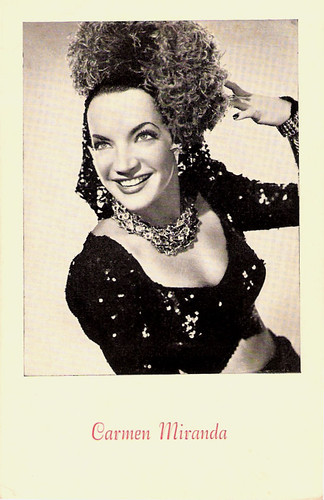
Dutch postcard. Carmen Miranda in Doll Face (Lewis Seiler, 1945).
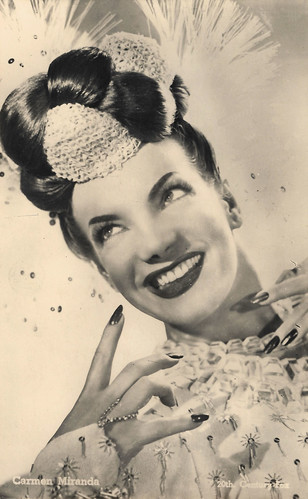
Dutch postcard by MPEA. Photo: 20th Century Fox.
Sources: Denny Jackson (IMDb), Catherine A. Surowiec (Cinema Ritrovato 2006), Hal Erickson (AllMovie), Bruce Eder (AllMovie), Kenneth Chisholm (IMDb), Telegraph, Wikipedia (Dutch) and IMDb.
No comments:
Post a Comment